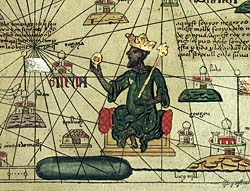
Unit 2: How Trade and Travel Changed the World
Lesson G: Avenues of Change in Africa
Lesson Overview

Mali King Mansa Musa I [1]
The expansion of travel and trade during 1300-1550 affected societies throughout the African continent. The rise of the Islamic Mali and Songhai empires in West Africa were influenced by cultural exchanges along trans-Saharan trade routes. Technological and cultural developments connected markets of East Africa with merchants in the Mediterranean and Indian Ocean networks. The diffusion of religion, such as Islam, and language, such as Swahili, reflected the role of travel and trade in regional changes. European demand for goods such as gold and salt, and the boom in the intercontinental slave trade, permanently impacted African control over their continent. The transition from the Medieval world to the early Modern Era created opportunities from some and crises for others.
Key Questions
- How and why did trade and interaction lead to changes in political, economic, and social systems?
- What factors contributed to the establishment, expansion, and decline of empires?
Student Outcomes
- Explain the causes and effects of Islamic expansion on political and cultural life in the Mali and Songhai Empires.
- Explain how West African Kingdoms participated in and profited from Eurasian trade routes, especially the trade of slaves, salt, gold, and ivory.
- Analyze the impact of trade in the economic and cultural development of East Africa, including the significance of Swahili.
- Identify the author or source of a historical document and explain the literal meaning of the document. (Historical Thinking Skill)
- Draw upon data from maps, charts, and graphs to form conclusions and generalizations. (Historical Thinking Skill)
- Analyze change or continuity in areas of the world over time based on text and non-text information. (Historical Thinking Skill)
Key Terms
Student Resources
- Historical Investigation — Africa's Islamic Capital (doc)
- Islam and Trade in Africa 1300-1550 Graphic Organizer (doc)
- Changes to West and East Africa Brief Constructed Response (BCR) (doc)
Chart of Activities
| Activities to Complete | Estimated Time |
|---|---|
| Pre-Assessment | 5 minutes |
| Key Terms | 5 minutes |
| Activator: The World 1300-1550 | 5 minutes |
| Opening: Travel and Trade Comes to Africa | 10 minutes |
| Activity 1: Travel, Trade and Islam in Africa | 15 minutes |
| Activity 2: Timbuktu, Africa's First Islamic Capital | 15 minutes |
| Activity 3: West African Trade Through Portuguese Contacts | 15 minutes |
| Activity 4: East African Trade and the Swahili Coast | 15 minutes |
| Activity 5: The Gold, Slave and Swahili Coasts | 15 minutes |
| Review and Assessment | 15 minutes |
| Lesson Summary | 5 minutes |
Lesson Completion Time
The total estimated time to complete this lesson is 120 minutes.
Page Notes:
[1] Source: This image from http://en.wikipedia.org/wiki/File:Mansa_Musa.jpg is in the public domain because its copyright has expired.

